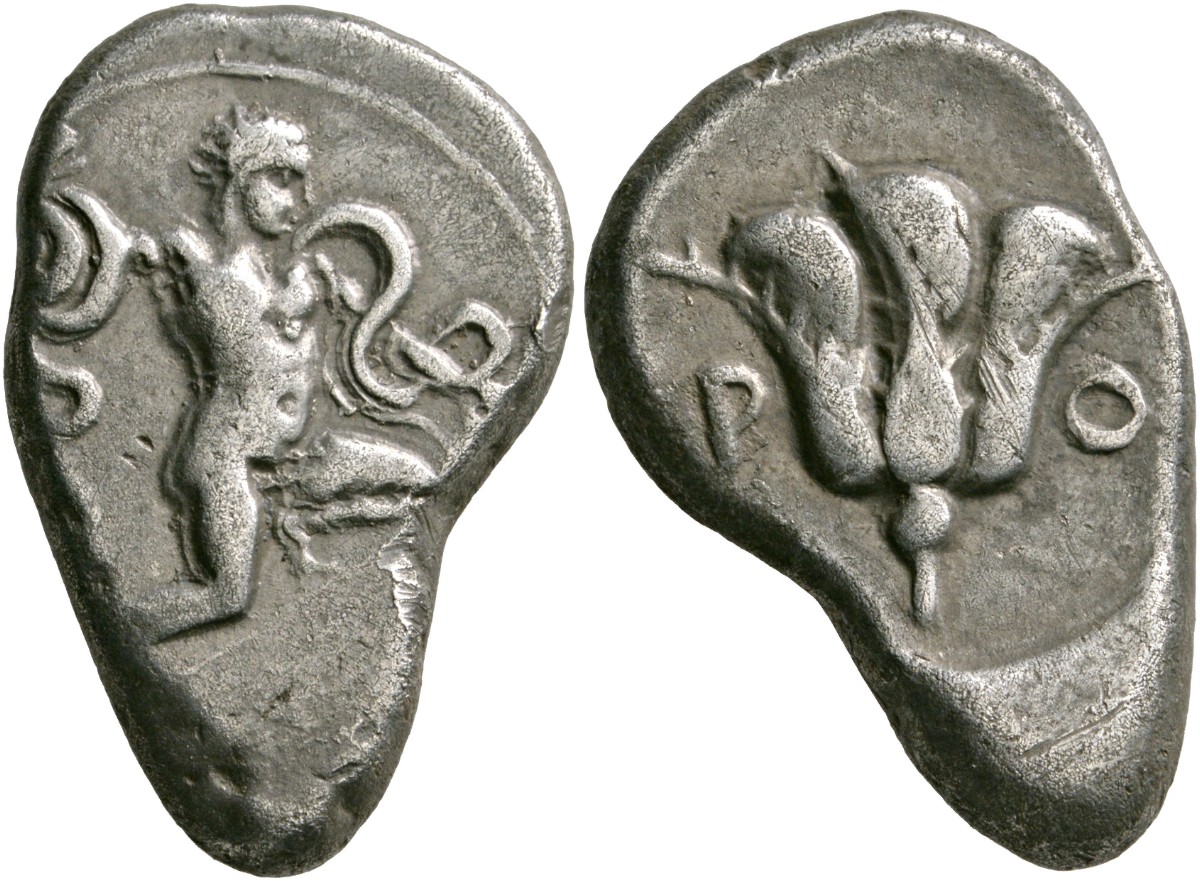Rhodes, silver, double sigloi (Heracliscus/rose) (408-404 BCE)
From SILVER
408 BCE - 404 BCE Silver 215 kg
Description
| ObverseInscription or printing placed on the obverse.: | The infant Herakles wrestling with two snakes |
| ReverseInscription or printing placed on the reverse.: | P - O (Greek).Rose |
Mint and issuing power
| MintIdentifies the place of manufacture or issue of a numismatic object.: | Rhodes | Ancient regionAncient region.: | Caria (islands) | Modern countryModern country: Greece | AuthorityIdentifies the issuing power. The authority can be "pretended" when the name or the portrait of X is on the coin but he/she was not the issuing power. It can also be "uncertain" when there is no mention of X on the coin but he/she was the issuing power according to the historical sources: | Rhodian power |
Chronology
| FromIdentifies the initial date in a range assigned in a numismatic context. | 408 BCE | toIdentifies the final date in a range assigned in a numismatic context.. | 404 BCE | PeriodTime period of the numismatic object.: Classical 480-323 BC |
Physical description
| MetalThe physical material (usually metal) from which an object is made.: | Silver |
Median weightMedian of the weights of numismatic objects (in grams). in grams | 11.10 | DenominationTerm indicating the value of a numismatic object. Examples: tetradrachm, chalkous, denarius.: | double siglos |
StandardStandard.: | Persian |
Image

S1953 Rhodes double sigloi herakles.jpg [1]
References
| Die study referencePublication of the study: | Ashton 20011Ashton 2001, n° 10, Ashton - Kinns - Konuk - Meadows 20022Ashton - Kinns - Konuk - Meadows 2002, p. 158, n° 1-3 | ||
| Coin series referenceReference to coin series study: | Sear II3Sear II, n° 5031 | ||
| Coin series web referenceCoin series web references: | |||
Obverse dies distribution
| FrequencyFrequency of specimen in distribution. ᵖ | Number of obversesNumber of obverse dies. ᵖ (o) | % (o) | Number of coinsNumber of coins. (n) | % (n) | Die nameName(s) of the die(s). |
| 24 | 1 | 100 | 24 | 100 | 1 |
| Total | 1 of 1 | 100 | 24 of 24 | 100 |
Reverse dies distribution
no distribution is available
Quantification
| Number of obversesNumber of obverse dies. ᵖ (o) | 1 | Number of singletons (o1)The number of singleton coins. ᵖ | |
| Number of reverse diesNumber of reverse dies. (r) | 3 | Number of coinsNumber of coins. (n) | 24 |
| Coins per obverse dieNumber of coins per obverse die. (n/o) | 24 | Coins per reverse dieNumber of coins per reverse die. (n/r) | 8 |
| Reverse per obverse ratioRatio of obverse dies divided by reverse dies. (r/o) | 3 | Percentage of singletons (o1)number of coins (n) divided by the number of singletons (o1) ᵖ | % |
| Original number of dies (O) (Carter 1983 formula)The estimation of the number of coins according to Carter 1983 ᵖ | 0.97 | Coins struck if 20,000 as average productivity per dieCoins made if the average productivity for obverses (according to Carter) is 20,000. ᵖ | 19,400 |
| Original number of dies (O) (Esty 2011 formula)The estimation of the number of coins according to the singleton formula in Esty 2011 ᵖ (O) | 1.04 | Survival rate if 20,000 as average productivity per dieSurvival rate if average productivity is 20,000. ᵖ | 0.00124 |
| Coverage (o = % of O) (Esty 1984 formula)Esty 1984 - coverage (% of O) ᵖ (o = % of O) | % | Die productivity if survival rate 1/2,000Average productivity if survival rate is 1/2,000. ᵖ | 49,484.54 |
| Weight of silver (in kg) if 20,000 coins per die (O = Carter formula)Carter 1983 * Median weight * 20000 (*10 if gold or electrum) ᵖ | 215 kg <br /> 215 kg | Die productivity if survival rate 1/5,000Average productivity if survival rate is 1/5,000. ᵖ | 123,711.34 |
Remarks
Most likely one single workstation Likely military
References
- ^ Ashton, Richard (2001), "The coinage of Rhodes 408-c.190 BC", in Andrew Meadows and Kirsty Shipton (eds.), Money and its uses in the ancient world, Oxford, Oxford University Press, p. 79-115.
- ^ Ashton, Richard - Kinns, Philip - Konuk, Koray - Meadows, Andrew (2002), "The Hecatomnus Hoard (CH 5.17, 8.96, 9.387)", Coin Hoards, IX, London, p. 95-158
- ^ Sear, David R. (1979), Greek coins and their values. Vol. II, Asia and North Africa, London, xlviii, p. 317-762